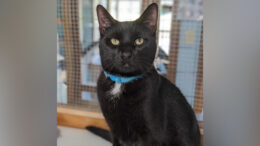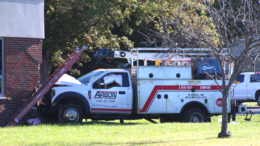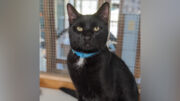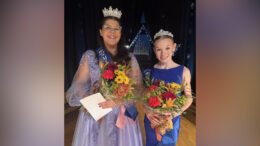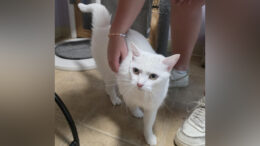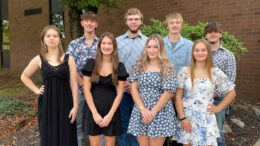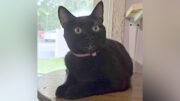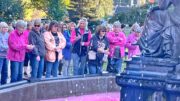Japanese beetles are not picky about the flowers and leaves they attack. They have favorites like roses and grapes, but many problems begin when the beetles are still in their larval form, called grubs.
Accidentally introduced into New Jersey in 1916 with nursery stock for the World’s Fair, Japanese beetles (Popillia japonica ) are now well-known in the eastern United States. Native to Japan, where they are not a pest, this pretty coppery-green metallic beetle is about 3/8-inch
long. As adults, they are aggressive pests of both agricultural and ornamental plants. As larvae, the white grubs are pests of grasses in pastures and lawns.
Can you manage these ravenous insects in your home garden? Yes! There are insecticidal and nonchemical options for reducing the number of Japanese beetles in your yard. To be sure, you cannot eliminate them, but their damage will be reduced. Use vulnerable times in the beetles’ life cycle to manage them.
Figure 1. Japanese beetle. (https://extension.psu.edu/japanese-beetles-in-the-home-garden)
Figure 2. Japanese beetle grubs curl into a C-shape and have tan heads and six legs.
Photo: Alton N. Sparks, Jr., University of Georgia,
Adult beetles emerge from their pupae in the soil in mid-June to early July. They feed on leaves, flower buds, or fruits and mate. Each female lays up to 60 eggs in the ground over two weeks. The eggs survive best in moist soil and hatch a few weeks later. The tiny grubs remain only a few inches below the surface and feed on grass roots causing damage. Most of the damage occurs from late August through early October by thousands of hungry, small grubs. Older and larger grubs move deeply into the soil for the winter. They feed very little in the spring and soon become non-feeding pupae until mid-June, when their life cycle begins again.
The first popular option, a trap for adults, is not recommended! Japanese beetle traps were created to monitor the beetles’ westward expansion. Traps contain a floral scent attractant plus a sex pheromone to bait additional males. They trap only 75 percent of the beetles they attract. That means the plants in your yard feed the rest of the beetles attracted by the trap. If you allow dead beetles to remain in the traps, the efficiency decreases even more!
A simple and effective control method works in the early morning or evening. Walk through the yard and handpick or knock the beetles into a bowl of sudsy water. When the temperature is cool, they fall off instead of flying away. Since the smell of dead beetles repels living beetles, try placing containers of trapped or handpicked beetles near your desirable plants. Be aware that the odor of dead insects offends people, too.
Organic insecticides vary in effectiveness. Insecticidal soap is effective on small, soft insects but not on adult beetles. Neem oil is somewhat effective. Pyrethrin, derived from chrysanthemums, is somewhat effective. Spinosad, derived from bacteria, is effective but does not offer a fast kill and requires re-application.
Conventional broad-spectrum insecticides are non-selective. These kill all insects, including natural predators. The pyrethroids, like bifenthrin, lambda-cyhalothrin, deltamethrin, or zeta-cypermethrin, are effective on Japanese beetle adults. Carbaryl and acephate also work. Do not apply when plants are flowering to reduce harm to pollinators.
Managing grubs reduces the damage to turfgrasses. Proper maintenance of the lawn is essential. Mowing at a greater height increases the depth and strength of the root system of the turfgrass. Occasional deep irrigation is better for the grasses and less desirable for the beetles. Female beetles lay their eggs in moist soil. Egg and young grub survival are more successful in a lawn that receives frequent, shallow watering. From late June to late July, allow the turfgrass to go dormant.
Beneficial (entomopathogenic) nematodes are microscopic roundworms that infest grubs. Purchase and apply Heterorhabditis or Steinernema species annually after the ground has warmed in the late spring. Application techniques must be followed precisely for
success.
Milky spore (Paenibacillus popilliae) is a naturally occurring bacterial disease of grubs. Its application technique varies by product form. It builds up slowly in the soil and works only on Japanese beetle grubs, not any other species of white grubs.
B t g is another naturally occurring bacterial product that works well. Bacillus thuringiensis galleriae manages all species of grubs.
Chemical treatments are often applied to turfgrasses with varying success. Correct product, application, and timing are essential to be effective. While grub damage occurs in late summer and autumn, it is not noticed until spring. Spring is an inappropriate time to apply a grub control product as the grubs are large, deep in the soil, and feed very little. Be aware that some insect control products kill soil surface insects but have limited control over grubs that dwell within the ground. Treatment with trichlorfon or chlorantraniliprole control Japanese beetle grubs in the soil. Systemic products like imidacloprid are effective on insects but travel throughout the plant into the flowers of clover and other flowers and are toxic to our needed pollinators.
Adult Japanese beetles are excellent flyers and respond to the scent of damaged foliage. They will enter your yard from other areas. Consider replacing some of your plants that Japanese beetles severely injure with plants that are rarely damaged. Your landscape’s appearance will improve, and your workload will decrease. Lists of susceptible and resistant plants are given in Managing the Japanese Beetle: A Homeowner’s Handbook (https://www.aphis.usda.gov/sites/default/files/JBhandbook.pdf) by the United
States Department of Agriculture.
More Information
- Less Harmful Pesticides(https://extension.psu.edu/less-harmful-pesticides)
- White Grubs—Underground Marauders in Turf(https://extension.psu.edu/white-grubs-underground-marauders-in-turf)
- White Grubs in Home Lawns(https://extension.psu.edu/white-grubs-in-home-lawns)
- Not All Grubs Are Alike(https://extension.psu.edu/not-all-grubs-are-alike)
- Japanese Beetles in Brambles in the Home Fruit Planting
(https://extension.psu.edu/japanese-beetles-in-brambles-in-the-home-fruit-planting)
- Japanese Beetle(https://extension.psu.edu/japanese-beetle)
Authors
Mary Jo R. Gibson
Master Gardener, Columbia County


